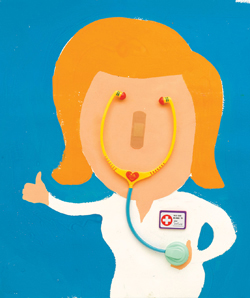The link between doctor and patient health
Hanoch Piven |
|
 |
|
By BRIAN LEE
Doctors and medical students have an extra reason to get fit. Physicians who practice good health habits are more likely to counsel patients to do likewise.
Not only that, but when doctors discuss their habits, patients are more likely to take the suggestions to heart, says Erica Frank, MD, principal investigator of “Healthy Doc-Healthy Patient,” a questionnaire survey of 2,316 medical students.
Earlier this year, Frank published findings in Preventive Medicine indicating medical students with healthy routines more often advised patients about prevention — mirroring her earlier findings for physicians.
“Medical students who are encouraged to be healthy are more likely to become doctors who talk about prevention,” says Frank, a professor at the University of British Columbia and a former postdoctoral fellow at what is now called the Stanford Prevention Research Center.
Frank also oversaw the Women Physicians’ Health Study, a national questionnaire survey of 4,501 female physicians. Her research indicates both medical students’ and doctors’ practice of a healthy behavior predicted whether they counseled patients on related prevention issues. For example, physicians who ate less fat were more likely to tell patients how to lower cholesterol through lifestyle changes, while physicians who slathered on sunscreen were most likely to counsel about skin cancer.
Related News
The counseling is worthwhile, as a physician’s advice can lead patients to alter even the most recalcitrant habit. According to a 2004 study by the Cochrane Collaboration, a nonprofit organization dedicated to evidence-based medicine, when doctors told smokers to stop, the brief advice increased the chances patients quit by 2.5 percent.
Doctors are already pretty healthy, Frank says, and have better habits than most people. Her study found the habits of female physicians were healthier than those of other high-socioeconomic-status women. The results indicated that only 4 percent of female physicians smoked, versus 8 percent of women of high socioeconomic status and 25 percent of the general population. Similarly, she has found male physicians on average live two years longer than other professionals and three years longer than the general population.
But physicians still have room to improve. A 2004 study of 85,000 male physicians found that 44 percent were overweight and 6 percent were obese. While this percentage is lower than the national average, physicians need to understand the role model they play for patients, says coauthor JoAnn Manson, MD, DrPH, professor of women’s health at Harvard Medical School. “We will have much more credibility promoting lifestyle modifications to our patients if we also ‘walk the walk,’” Manson says.
One easy habit doctors can start, Frank says, is sharing their existing healthy practices with patients. In 2000, Frank showed two groups of study subjects an exercise and diet video. But one group was exposed to 30 seconds of extra content: A physician with an apple and bike helmet visible on her desk describing her own good health habits. The subjects who saw this version of the video rated the advice as more authentic and inspiring. Notes Frank: “Physicians who share their healthy personal habits, for even an extra half-minute, are more believable and motivating to patients.”
Comments? Contact Stanford Medicine at

